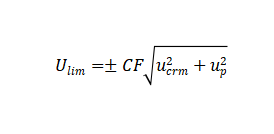What is accuracy and how do we calculate it?
2023-07-13WIKI
In laser diffraction particle size analysis, an accuracy test describes consistency between the measurement result of the certified reference material and its nominal value. For the accuracy test, each certified reference material needs to be measured at least three times individually. Every test should be conducted in the presence of sufficient and proper sample concentration, enabling good representative results.
Based on ISO 13320: 2020, the acceptance limit Ulim for the accuracy test can be calculated through the following formula:

where Up is the maximum acceptable instrument uncertainty value for a laser diffraction system, CF is the coverage factor. Up and CF are shown in the following table. Ucrm can be found in the instructions provided for the certified reference material. The coverage factor describes the confidence of certain data within a defined standard deviation, which is dependent on the application area. For example, in the metrology industry, when uncertainty to a confidence interval of 95% is given, the coverage factor can be considered 2.




